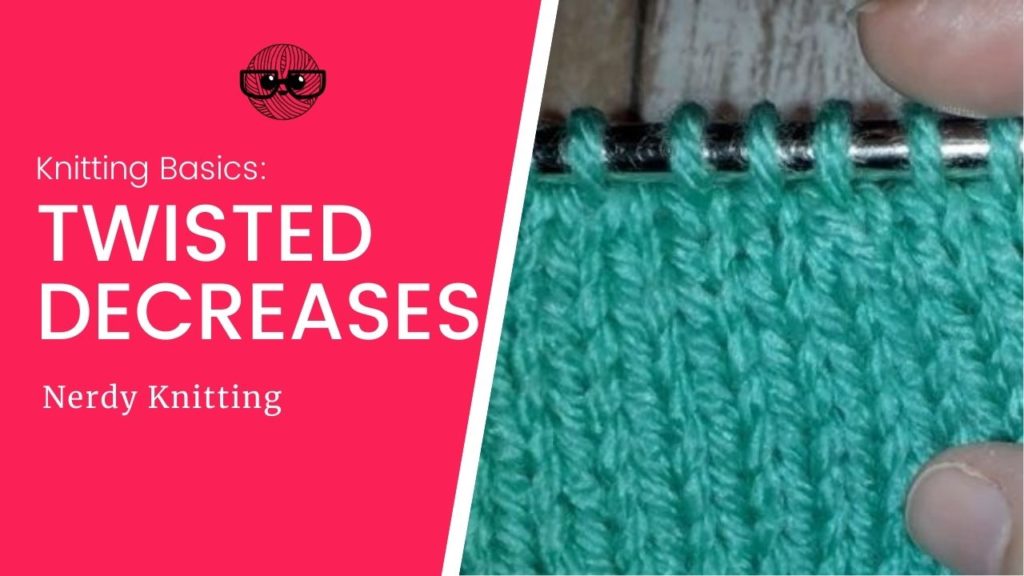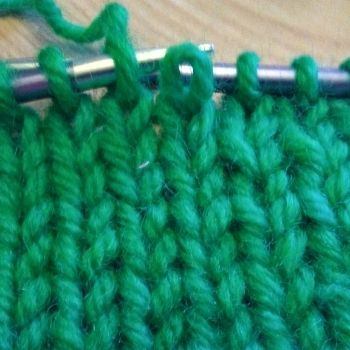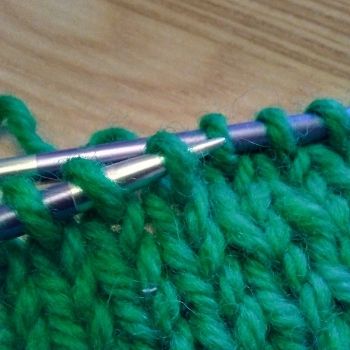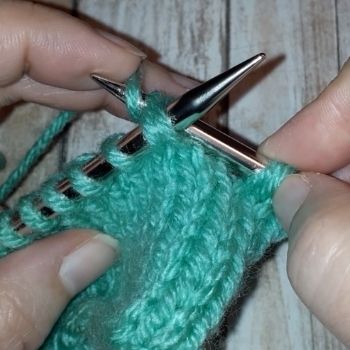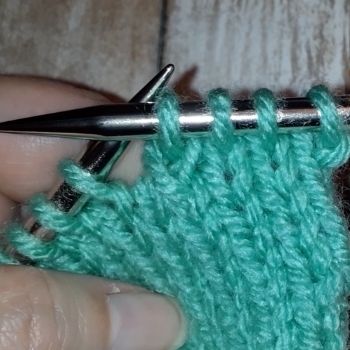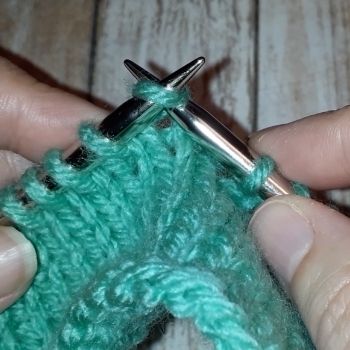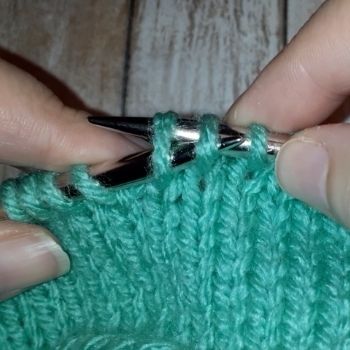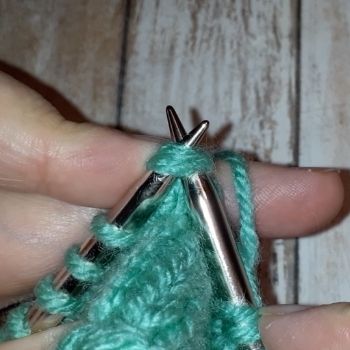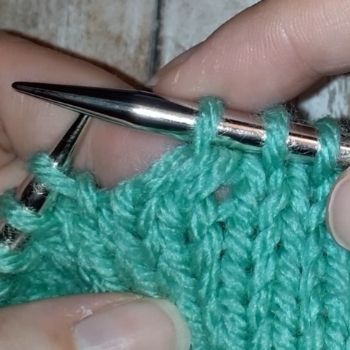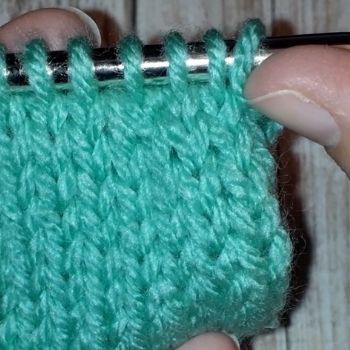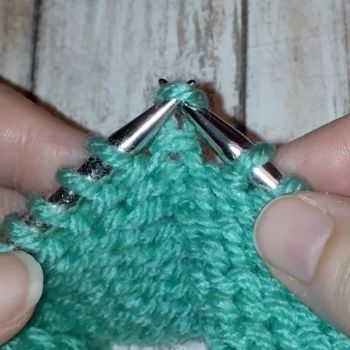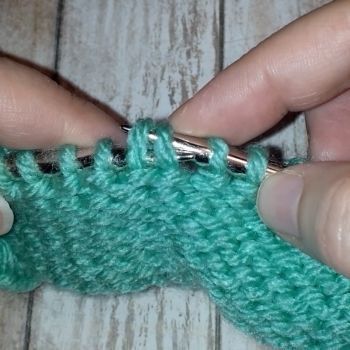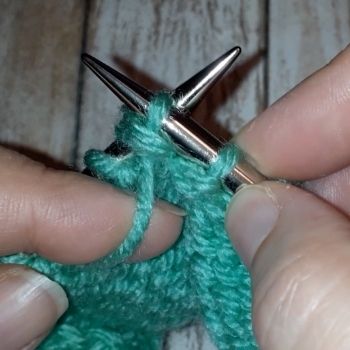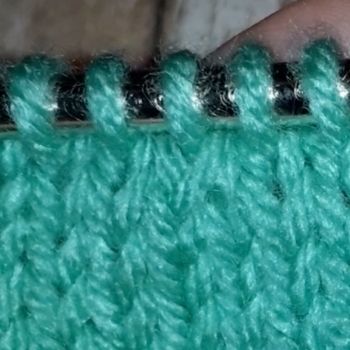Twisted stitches are decorative stitches that can be used in many ways – twisted and traveling cables, twisted ribs, or even twisted decreases worked in a sweater. When working patterns that use twisted stitches you may be required to work a decrease and a twisted decrease would be recommended to maintain the look of the fabric.
We’ll look at the following twisted decreases in this article:
- K2tog-tbl (knit two together through the back loops)
- Twisted SSK (twisted slip, slip, knit)
- P2tog-tbl (purl two together through the back loops)
- Twisted SSP (twisted slip, slip, purl)
The K2tog-tbl and Twisted SSK are the most common and can be used in most situations, especially when working decreases in Stockinette fabric. The P2tog-tbl and Twisted SSP are the purlwise equivalents of these twisted decreases and can be used on the wrong side of the work when the right side fabric is Stockinette, in reverse Stockinette, or whenever a purl decrease is required.
We’ll look at each of these increases – how to work them as well as how to pair them for mirrored decreases.
What are Twisted Stitches & Decreases
Twisted stitches and decreases are decorative, more pronounced, and produce tighter stitches (when compared to standard stitches). They are created by intentionally working a stitch so the legs are crossed or twisted. To understand how this works, you must first understand the standard stitch mount.
In North America and European countries, the standard western method is commonly used. In this standard western stitch mount, stitches sit on the needle with the leading leg (the right leg) to the front of the needle and the left leg to the back of the needle.
The images below demonstrate this. The first image shows an open, untwisted stitch. The second image shows how that stitch sits on the needle in the standard western stitch mount.
In order to twist these stitches or work twisted decreases, they are worked through the back legs (the left legs – the non-leading legs) to twist them.
Twisted Decreases on a Knit Row
As stated above, the most common twisted decreases are the K2tog-tbl (knit two together through the back loops) and the Twisted SSK (twisted slip, slip, knit). What’s interesting about these twisted versions is their slant. A standard K2tog leans to the right while the twisted K2tog-tbl leans to the left. The standard SSK leans to the left while the Twisted SSK leans to the right.
It’s important to remember that these twisted versions of the decreases have a different slant – especially when you are using them for shaping and want to work paired decreases that mirror each other. If that is the case, you would want to work one twisted decrease (for example, the Twisted SSK) at the right edge of the garment and work a K2tog-tbl at the left edge on the same row to mirror the slant of the Twisted SSK.
If you work the decreases so they follow the slant of the fabric, these are referred to as blended decreases. For a more prominent line of decrease shaping, switch them around so the decreases slant towards the edge (which is referred to as full-fashioned shaping).
To work paired twisted decreases:
- consider the slant of the decreases – they should lean in opposite directions
- work them on the same row
- work them at the same location at opposite edges
K2tog-tbl
The K2tog-tbl (knit two together through the back loops) is the easiest twisted decrease to work and produces a left-slanting decrease. It may also be abbreviated ‘Tk2tog’
To work this decrease, insert the right needle into the back legs of the first two stitches on the left needle and knit them together from that position.
The second image below shows how this method twists the legs of the stitches and leans to the left.
Twisted SSK
The Twisted SSK (twisted slip, slip, knit) takes a few more steps to work. It’s very similar to the standard SSK – stitches are still slipped knitwise – but they are worked differently after that and the resulting decrease leans to the right instead of the left. You may also see it abbreviated as ‘Tssk’.
To work the Twisted SSK:
- Slip two stitches knitwise, one at a time, from the left needle to the right. (Image 1 below)
- Slip these two stitches (slipping them purlwise) back to the left needle maintaining this new stitch mount. (Image 2 below)
- Knit these two stitches together. (Image 3 below)
The final image below shows how this Twisted SSK stitch looks – the legs are twisted and it slants to the right.
The image below shows how these two twisted decreases can be paired. The Twisted SSK to the left (3rd stitch from left edge) and K2tog-tbl to the right (3rd stitch from the right edge).

Twisted Decreases on a Purl Row
Twisted decreases can also be worked in purl stitches or on the purl side (reverse Stockinette) of a project. The P2tog-tbl is the purlwise equivalent of the K2tog-tbl and the Twisted SSP is the purlwise equivalent of the Twisted SSK. And, like their knitwise version, the twisted decreases slant in different directions.
The P2tog-tbl and Twisted SSP decreases are commonly used on the wrong side of the work when the right side is Stockinette fabric. When they are used in this manner, the P2tog-tbl leans to the left when viewed from the right side of the work and the Twisted SSP leans to the right.
Like the knit versions of these twisted decreases, you’ll want to keep the slant of the decreases in mind when you are working them as paired decreases. For example, you could work the Twisted SSP at the right edge of the garment (to follow the slant of the fabric) and work a P2tog-tbl at the left edge (to follow the slant of the left edge). This produces a blended decrease because the decreases follow the slant of the garment. But remember, that this assumes you are working them on the wrong side of the work to produce slanted shaping on the right side of the work.
While working them on the wrong side of the work is probably the most common way to use them (especially if you need to work decreases on every row of a particular garment), they can also be used if the fabric is reverse Stockinette or a textured pattern where purl stitches are dominant. When the decreases are worked in this fabric, the slant of the decreases is not noticeable.
P2tog-tbl
The Twisted P2tog-tbl is fairly simple to work (not quite as simple as a K2tog-tbl) and it leans left on the front of the work.
To work this twisted decrease, insert the right needle into the first two stitches on the left needle into the back legs of the stitches from left to right, inserting into the second stitch and then into the first stitch (this position is referred to as purling through the back loops). While in this position, purl the two stitches together. (Image 1 below)
The second image below shows how this looks on the right side of the work – the decrease is twisted and leans to the left.
Twisted SSP
The Twisted SSP is similar to the knit version – the first two stitches are slipped knitwise. But they are worked differently after the stitch mount has been adjusted and the resulting decrease leans to the right when viewed from the front of the work.
To work the Twisted SSP:
- Slip two stitches knitwise one at a time from the left needle to the right needle. (Image 1 below)
- Slip these two stitches (purlwise) back to the left needle, maintaining the new stitch mount. (Image 2 below)
- Purl the two stitches together. (Image 3 below)
The final image below shows the resulting decrease when viewed from the right side of the work – the legs of the stitch are twisted and leans to the right.
The image below shows how these two purlwise twisted decreases can be paired. The Twisted SSP to the left of the swatch (3rd stitch from left edge) leans to the right and P2tog-tbl on the right side of the swatch (3rd stitch from the right edge) leans to the left.

While standard, untwisted decreases are the most common, it’s good to know that there are other methods that can be used. Twisted decreases produce a more decorative final decrease edge when worked in Stockinette and, if you plan to work any patterns that use twisted or traveling twisted stitches or cables, they are important to know.
For more information about twisted decreases, take a look at the resources linked below.
Recommended Resources
- Vogue Knitting (available on Amazon)
- The Principles of Knitting by June Hemmons Hiatt (available on Amazon)
- Increase, Decrease by Judith Durant (available on Amazon)
- “Single Knit Decreases” by Binka Schwan, Cast On (The Knitting Guild Association)
- “Decreases Part 2” by Arenda Holladay, Cast On (The Knitting Guild Association)
More Knitting Techniques
- How to Decrease in Knitting (6 Basic Techniques for Every Knitter)
- How to Decrease on a Purl Row in Knitting
- How to Knit Double Decreases (10 Different Ways!)
